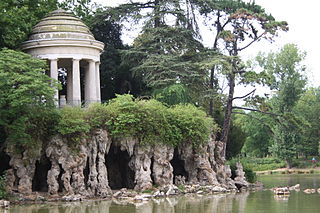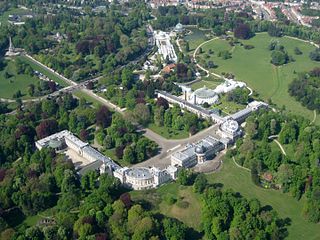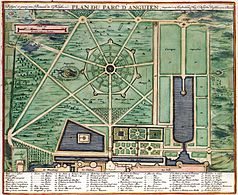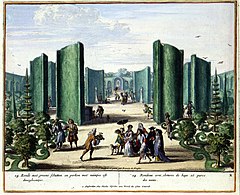
Val-d'Oise is a department in the Île-de-France region, Northern France. It was created in 1968 following the split of the Seine-et-Oise department. In 2019, Val-d'Oise had a population of 1,249,674.

Enghien is a city and municipality of Wallonia located in the province of Hainaut, Belgium.

Louis Antoine de Bourbon, Duke of Enghien was a member of the House of Bourbon of France. More famous for his death than his life, he was executed by order of Napoleon Bonaparte, who brought charges against him of aiding Britain and plotting against Napoleon.

The Bois de Vincennes, located on the eastern edge of Paris, France, is the largest public park in the city. It was created between 1855 and 1866 by Emperor Napoleon III.

Brussels Park is the largest urban public park in central Brussels, Belgium. Formerly known and still sometimes colloquially referred to as the Royal Park, it was the city's first public park, being originally laid out between 1776 and 1783 in a neoclassical style by the French architect Gilles-Barnabé Guimard and the Austrian landscape architect Joachim Zinner, as part of an urban project including the Place Royale/Koningsplein. The area of the rectangular park is 13.1 ha.

The Egmont Palace, also sometimes known as the Arenberg Palace, is a neoclassical palace in Brussels, Belgium. It was originally built between 1548 and 1560 for Countess Françoise of Luxembourg and Count Lamoral of Egmont, though its appearance was heavily modified in the 18th and 19th centuries. It was partly destroyed by fire in 1892, after which it was once again reconstructed. Nowadays, it is used by the Belgian Ministry of Foreign Affairs for receptions, as a guest house and conference centre.

Charles de Wailly was a French architect and urbanist, and furniture designer, one of the principals in the Neoclassical revival of the Antique. His major work was the Théâtre de l'Odéon for the Comédie-Française (1779–82). In his designs, de Wailly showed a predilection for the perfect figure, the circle.

The Palace of Laeken or Castle of Laeken is the official residence of the King of the Belgians and the Belgian royal family. It lies in the Brussels-Capital Region, 5 km (3 mi) north of the city centre, in Laeken, and sits in a large private park called the Royal Domain of Laeken.

The House of Arenberg is an aristocratic lineage that is constituted by three successive families that took their name from Arenberg, a small territory of the Holy Roman Empire in the Eifel region. The inheritance of the House of Croÿ-Aarschot made the Arenbergs the wealthiest and most influential noble family of the Habsburg Netherlands. The family's Duchy of Arenberg was a Sovereign State until it was mediatized in 1810. As such, the Arenbergs belong to the small group of families that constitute the Hochadel.

Princely Count Charles of Arenberg, duke of Aarschot, baron of Zevenbergen, knight of the Order of the Golden Fleece, was the second Princely Count of Arenberg and a leading aristocrat of the Habsburg Netherlands, who served as a courtier, soldier, minister and diplomat.

The Vauxhall of Brussels, otherwise known as the Waux-Hall, is a historic performance hall in Brussels Park in Brussels, Belgium. It is named after the pleasure gardens of Vauxhall in London, which only became known to the inhabitants of Brussels in 1761, when a ballet entitled Le Phaxal was put on at the Theatre of La Monnaie. In Paris, the stage-builder Torré opened a "garden of amusements" in 1764, which the public came to call the Vaux-Hall de Torré. A Vaux-Hall d'hiver was set up in 1769 at the Foire Saint-Germin.
Charles Borremans, was a composer of operas, and a violinist and conductor at the Théâtre Royal de la Monnaie in what was then France and later the United Kingdom of the Netherlands from 1804 to 1825. The composer Charles-Louis-Joseph Hanssens succeeded him as conductor of this opera house.

The Brussels International Exposition of 1897 was a world's fair held in Brussels, Belgium, from 10 May 1897 through 8 November 1897. There were 27 participating countries, and an estimated attendance of 7.8 million people.

The Château de Châtillon-Coligny is a castle, later replaced with a smaller château, in the commune of Châtillon-Coligny in the Loiret département of France.
Ghislain-Joseph Henry (1754-1820) was an architect, garden designer and topiarist, notable for his work for Louis XVI of France, the Holy Roman Emperor, Napoleon I and William I of the Netherlands.

The Château de Braine was a château in Braine, Aisne, Picardy, France. It served as a country home for the counts of Egmont-Pignatteli, and its gardens were designed by André Le Nôtre.

The Château de Valmer is a complex located northeast of Chançay, a French commune in the Indre-et-Loire department of the Centre-Val de Loire region. It was built in 1524 by remodeling a medieval castle of the Binet family and was renovated and expanded in the second half of the 17th century. After numerous other changes and repairs during the 19th and 20th centuries, the main building was almost destroyed by a fire in 1948.

The Château of Mariemont was a royal residence and hunting lodge for the governors of the Habsburg Netherlands. It was located in Mariemont, in today's village of Morlanwelz, Belgium.

Tervuren Castle was a moated castle constructed by the dukes of Brabant, which later became a royal residence and hunting lodge for the governors of the Habsburg Netherlands. It was located in Tervuren, Belgium, just outside Brussels. It was demolished in 1782.












































